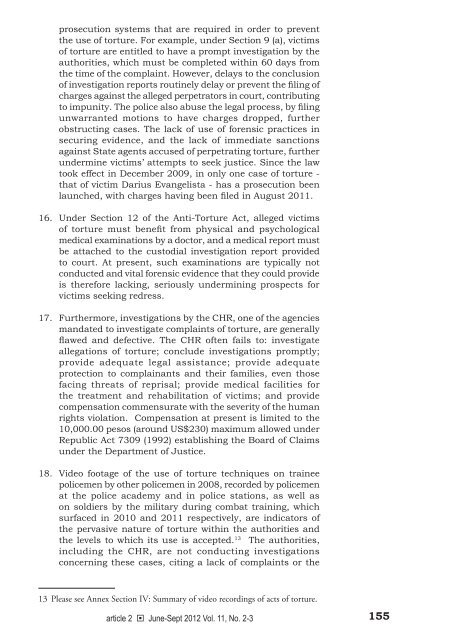Create successful ePaper yourself
Turn your PDF publications into a flip-book with our unique Google optimized e-Paper software.
prosecution systems that are required in order to prevent<br />
the use of torture. For example, under Section 9 (a), victims<br />
of torture are entitled to have a prompt investigation by the<br />
authorities, which must be completed within 60 days from<br />
the time of the complaint. however, delays to the conclusion<br />
of investigation reports routinely delay or prevent the filing of<br />
charges against the alleged perpetrators in court, contributing<br />
to impunity. The police also abuse the legal process, by filing<br />
unwarranted motions to have charges dropped, further<br />
obstructing cases. The lack of use of forensic practices in<br />
securing evidence, and the lack of immediate sanctions<br />
against State agents accused of perpetrating torture, further<br />
undermine victims’ attempts to seek justice. Since the law<br />
took effect in December 2009, in only one case of torture -<br />
that of victim Darius Evangelista - has a prosecution been<br />
launched, with charges having been filed in August 2011.<br />
16. under Section 12 of the Anti-Torture Act, alleged victims<br />
of torture must benefit from physical and psychological<br />
medical examinations by a doctor, and a medical report must<br />
be attached to the custodial investigation report provided<br />
to court. At present, such examinations are typically not<br />
conducted and vital forensic evidence that they could provide<br />
is therefore lacking, seriously undermining prospects for<br />
victims seeking redress.<br />
17. Furthermore, investigations by the ChR, one of the agencies<br />
mandated to investigate complaints of torture, are generally<br />
flawed and defective. The CHR often fails to: investigate<br />
allegations of torture; conclude investigations promptly;<br />
provide adequate legal assistance; provide adequate<br />
protection to complainants and their families, even those<br />
facing threats of reprisal; provide medical facilities for<br />
the treatment and rehabilitation of victims; and provide<br />
compensation commensurate with the severity of the human<br />
rights violation. Compensation at present is limited to the<br />
10,000.00 pesos (around uS$230) maximum allowed under<br />
Republic Act 7309 (1992) establishing the Board of Claims<br />
under the Department of Justice.<br />
18. Video footage of the use of torture techniques on trainee<br />
policemen by other policemen in 2008, recorded by policemen<br />
at the police academy and in police stations, as well as<br />
on soldiers by the military during combat training, which<br />
surfaced in 2010 and 2011 respectively, are indicators of<br />
the pervasive nature of torture within the authorities and<br />
the levels to which its use is accepted. 13 The authorities,<br />
including the ChR, are not conducting investigations<br />
concerning these cases, citing a lack of complaints or the<br />
13 Please see Annex Section IV: Summary of video recordings of acts of torture.<br />
article 2 � June-Sept 2012 Vol. 11, No. 2-3<br />
155


